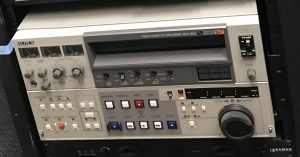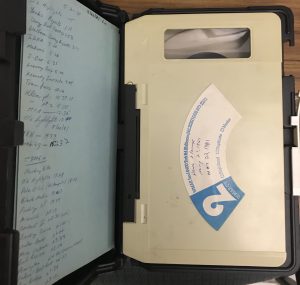When I started working at Special Collections and Archives in 2015, I was introduced to U-matic tapes. Being a millennial, I was familiar with VHS and Betacam, but I had never heard of U-matic tapes. I did some research and learned more about them. I had to learn how to use a U-matic VCR and how to play tapes on it safely. U-matic was first introduced by Sony in 1971 [1]. The high cost of manufacturing forced Sony to move U-Matic away from the consumer market into the industrial, professional, and educational sectors, including the television broadcasting industry in the mid-1970s, when local and national television networks used the format. U-matic tapes introduced an age of electronic recording of news, which eventually rendered obsolete the use of 16mm film cameras for on-location television news gathering. Videotape can be played instantly, allowing breaking news to be covered quicker [2].
Now I understand why so many of the tapes in the WMAR-TV news collection from the late 1970s to the 1980s are in this format. It was among the first video formats to use cassettes instead of reel-to-reel tape. The tape is played back, fast-forwarded, and rewind in the opposite direction compared to most other cassette-based formats: one reel runs clockwise and the other counterclockwise, with a one-hour recording time limit [3].
This information will help me deal with the tapes if they get stuck while playing in the player. However, continuously replaying the tapes significantly increases the likelihood of damaging them.


My name is Fatemeh Rezaei and I manage, preserve, and make accessible the WMAR-TV Collection at UBalt Special Collections & Archives. The material in this local TV news collection illustrates the social, cultural, political, and economic events of the state of Maryland and Baltimore City between 1948 and 1993. This collection contains approximately 4,000 films, 300 one- and two-inch quad videotapes, and 2,200 U-matic and VHS videocassettes.
UBalt Special Collections & Archives previously digitized 300 one- and two-inch quad videotapes. The videocassettes were then identified as the next most at-risk part of the collection. These tapes, all created during the 1970s and 1980s, are nearing the end of their useful lives and are already degrading. Due to that fact, we were forced to seek grant funding that will provide an opportunity to digitize and save historical footage from being lost forever.
However, it took us several years to complete a comprehensive assessment while also organizing and rehousing the videotapes, including assigning unique identification numbers to each cassette. Handling and physically inspecting each tape was part of this process. As a result, all descriptions, metadata, and shot lists associated with individual tapes are searchable and available online through our database.
Finally, in 2020, we were able to apply for the Recordings at Risk Grant and were awarded a 12-month project titled “Preserving and Providing Access to Baltimore Television News Station (WMAR), 1980-1985” in 2021.

The Recordings at Risk program is a national regranting program administered by Council on Library & Information Resources (CLIR) to support the preservation and digitization of rare and unique audio, audiovisual, and other time-based media of scholarly significance. The program is funded by The Andrew W. Mellon Foundation. The award enabled us to digitize 965 U-matic tapes with daily news clips from 1980 to 1985 to for use and preservation. Access to these historic clips is now possible through the Internet Archive website.
In addition to national events, these tapes include footage of local news stories, local festivals, local politics, sports events, and African American community events. The news covered topics like policing and its relationship to minorities, criminal justice reform, and regional development.
As part of Baltimore’s work to improve its reputation, many efforts were made to redevelop its downtown waterfront area (also known as Inner Harbor) in the late 1970s and 1980s. The digitized portion of the collection includes news about these developments, which can be particularly informative and useful to decision makers and researchers conceiving similar projects across the nation. Additionally, it covers a period of time documenting Baltimore’s popular, controversial, and longest serving mayor, William Donald Schaefer.
There are still more than 1000 tapes in this collection that need to be digitized as soon as possible. To preserve the historical footage of Baltimore and Maryland, we plan to find more grant opportunities to digitize the rest of the tapes.
Check out this short video on how to search the WMAR-TV collection:
Thanks to Aiden Faust, Associate Director of Special Collections and Archives, Margarita M. Cardona, Assistant Provost for Sponsored Research and Jeffrey Hutson, Dean of the RLB Library, who helped and supported this project.
________________________________
Reference
- https://www.sony.com/en/SonyInfo/CorporateInfo/History/sonyhistory-d.html
- https://en.wikipedia.org/wiki/U-matic#Introduction
- https://en.wikipedia.org/wiki/U-matic